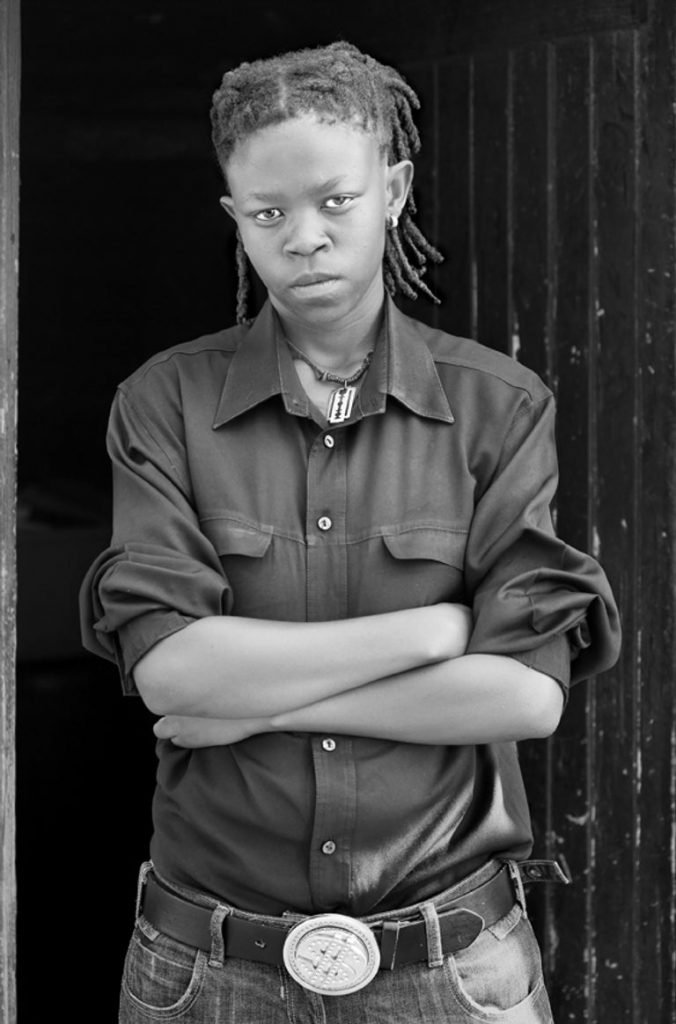Bongiwe “Twana” Kunene, Kwanele South, Katlehong, Johannesburg, 2012 (work of art)
Artwork Info
Key Ideas about this Work of Art
- The subject (identified in the title as Bongiwe “Twana” Kunene) stands in front of a wooden door with their arms crossed, wearing a dark-colored, button-down shirt with rolled-up sleeves, a cord pendant necklace, jeans, and a dollar-sign belt buckle. They confront the viewer with a steady, confident gaze. The image is black and white.
- Zanele Muholi began their Faces and Phases series in 2006 to increase LGBTI (particularly lesbian) visual representation across Africa, especially of victims of violence and sexual assault. Muholi seeks to increase the visibility of lesbians in South African visual culture to prevent such violence in the future.
- Many of the subjects of Faces and Phases look straight into the camera, displaying various identities, circumstances, and reactions to being photographed. As a widely acclaimed LGBTI artist making images of South African lesbians, Muholi gives LGBTI South Africans a sense of both individuality and community.
Learn More
Regarding their photographic images, Muholi says, “This is not art, this is life; each and every photo is someone’s biography.” This statement sums up the entirety of their series Faces and Phases, begun in 2006 and continuing today. Muholi captures the lives of the black queer community in South Africa, having photographed over 200 individuals to date. Each portrait in Faces and Phases acts as a personal biography of an individual in this community, many of whom are friends of the artist. Some of these individuals have experienced violence due to their sexuality. Muholi’s work is a form of visual activism for this community. Through these photographs Muholi not only attempts to bring visibility to the marginalized but also endeavors to reduce the stigma surrounding the LGBTI community in South Africa and prevent hate crimes against homosexuals.
Muholi works with their subjects to craft the image, either in a studio setting or in the “wild,” allowing each person to choose their wardrobe, stance, and position. Some of Muholi’s photographs, including this one, present a sitter whose gaze is more confrontational. The subjects of Mbali Zulu, KwaThema, Springs, Johannesburg, 2010 and Amanda Mapuma, Vredehoek, Cape Town, 2011 appear thoughtful and more vulnerable. The artist’s choice to use only black-and-white images is intentional, to “create a sense of timelessness—a sense that we’ve been here before, but we’re looking at human beings who have never before had an opportunity to be seen.” Muholi notes that their work does not represent the black queer community of other African countries; it is specific to their native South Africa. With this series, they give voices to the voiceless in South Africa. The portraits are forms of activism, gestures of defiance and the hope of self-acceptance by society.
tags: identity, perception, power, subjectivity, survival
“I wanted to fill a gap in South Africa’s visual history that, even 10 years after the fall of apartheid, wholly excluded our very existence.”
-Zanele Muholi
Additional Resources
Resources for Teachers:
- Watch a documentary clip about Muholi’s visual activism. (Teachers: please preview this resource prior to sharing with your class.)
- Learn more about how to respond to concerns about teaching about gender.
Resources for Students:
- Read more about South Africa.
- Watch an interview with the artist.
- Look at a timeline of South African art.

